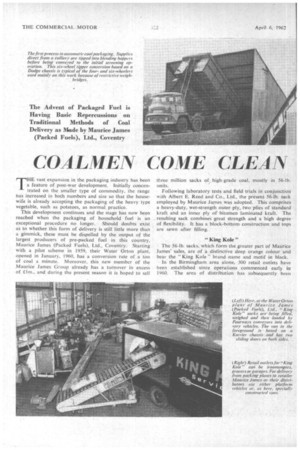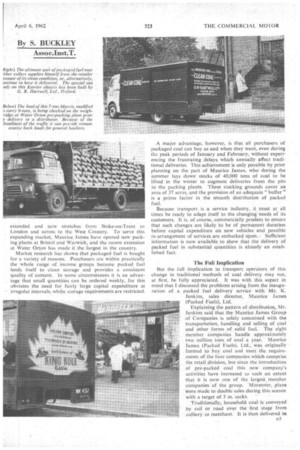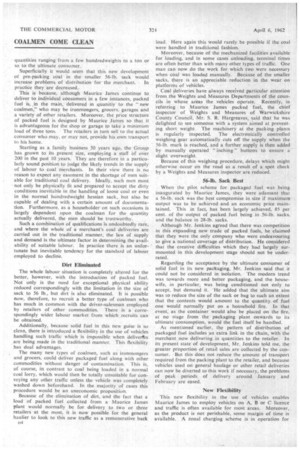COALMEN COME CLEAN
Page 68

Page 69

Page 70

Page 73

If you've noticed an error in this article please click here to report it so we can fix it.
The Advent of Packaged Fuel is Having Bask Repercussions on Traditional Methods of Coal Delivery as Made by Maurice James (Packed Fuels), Ltd., Coventry
THE vast expansion in the packaging industry has been a feature of post-war development. Initially concentrated on the smaller type of commodity. the range nas increased in both numbers and size so that the housewife is already accepting the packaging of the heavy type vegetable, such as potatoes, as normal practice.
This development continues and the stage has now been reached when the packaging of household fuel is an exceptional procedure no longer. Should doubts exist as to whether this form of delivery is still little more than a gimmick. these must be dispelled by the output of the largest producers of pre-packed fuel in this country. Maurice James (Packed Fuels), Ltd., Coventry. Starting with a pilot scheme in 1959, their Water Orton plant, opened in January, 1960, has a conversion rate of a ton of coal a minute. Moreover, this new member of the Maurice James Group already has a turnover in excess of -Elm., and during the present season it is hoped to sell three million sacks of high-grade coal, mostly in 56-1b. units.
Following laboratory tests and field trials in conjunction with Albert E. Reed and Co., Ltd., the present 56-1b. sack employed by Maurice James was adopted. This comprises a heavy-duty, wet-strength outer ply, two plies of standard kraft and an inner ply of bitumen laminated kraft. The resulting sack combines great strength and a high degree of flexibility. It has a block-bottom construction and tops are sewn after filling,
King Kole The 56-lb. sacks, which form the greater part of Maurice James' sales, are of a distinctive deep orange colour and bear the "King Kole brand name and motif in black.
In the Birmingham area alone, 500 retail outlets have been established since operations commenced early in 1960. The area of distribution has subsequently been
extended and now stretches from Stoke-on-Trent to London and across to the West Country. To serve this expanding market, Maurice James have opened new packing plants at Bristol and Warwick, and the recent extension at Water Orton has made it the largest in the country.
Market research has shown that packaged fuel is bought for a variety of reasons. Purchasers are within practically the whole range of income groups because packed fuel lends itself to clean storage and provides a consistent quality of content. In some circumstances it is an advantage that small quantities can be ordered weekly, for this obviates the need for fairly large capital expenditure at irregular intervals, whilst storage requirements are restricted. A major advantage, however, is that all purchasers of packaged coal can buy as and when they want, even during the peak periods of January and February, without experiencing the frustrating delays which annually affect traditional deliveries. This achievement is only possible by prior planning on the part of Maurice James, who during the summer lays down stocks of 40,000 tons of coal to be lifted in the winter to augment deliveries from the pits to the packing plants. These stocking grounds cover an area of 37 acres, and the provision of an adequate " buffer " is a prime factor in the smooth distribution Of packed fuel.
Because transport is a service industry, it must at all times be ready to adapt itself to the changing needs of its customers. It is, of course, commercially prudent to ensure that such changes are likely to be of permanent duration before capital expenditure on new vehicles and possible re-arrangement of services are embarked upon. Sufficient information is now available to show that the delivery of packed fuel in substantial quantities is already an established fact.
The Full Implication • But the full implication to transport operators of this change in traditional 'methods of coal delivery may not, at first, be. fully appreciated. It was with this aspect in mind that I discussed the problems arising from the inauguration of., a packed fuel delivery service with Mr. K. Jenkins, sales director, Maurice James (Packed Fuels), Ltd.
Explaining the pattern of distribution, Mr. Jenkins said that the Maurice James Group of Companies is solely concerned with the transportation, handling and selling of coal and other forms of solid fuel. The eight member companies handle approximately two million tons of coal .a year. Maurice James (Packed Fuels), Ltd., was originally formed to buy coal and meet the requirements of the four companies which comprise the retail division, but since the introduction of pre-packed coal this new company's activities have increased to such an extent that it is now one of the largest member companies of the group. Moreover, plans were Made to double sales during this season with a target of 3 m. sacks,
Traditionally, household coat is conveyed by rail or road over the first stage from colliery to merehant. It is then delivered in
quantities ranging from a few hundredweights to a ton or so to the ultimate consumer.
Superficially it would seem that this new development of pre-packing coal in the smaller 56-lb. sack would increase problems of distribution for the merchant. In practice they are decreased.
This is because, although Maurice James continue to deliver to individual consumers in a few instances, packed fuel is, sin the main, delivered in quanitiy to the " new coalmen," who may be ironmongers, grocers, garages and a variety of other retailers. Moreover, the price structure of packed fuel is designed by Maurice James so that it is advantageous for the shop or garage to take a minimum
load of three tons. The retailers in turn sell to the actual consumer who may, or may not, provide his own transport to his home.
Starting as a family business 50 years ago, the Group has grown to its present size, employing a staff Of over 200 in the past IC years. They are therefore in a particularly sound position to judge the likely trends in the supply of labour to coal merchants. In their view there is no reason to expect any easement in the shortage of men suitable for traditional coal delivery. Ideally, such men must not only be physically fit and prepared to accept the dirty conditions inevitable in the handling of loose coal or even in the normal hundredweight hessian sack,, but also be capable of dealing with a certain amount of documentation. Furthermore, as a householder on such occasions is largely dependent upon the coalman for the quantity actually delivered, the men should be trustworthy.
Such a combination of qualifications is undoubtedly rare, and where the whole of a merchant's coal deliveries are carried out in the traditional manner, the law of supply and demand is the ultimate factor in determining the availability of suitable labour. In practice there is an unfortunate but inevitable tendency for the standard of labour employed to decline.
Dirt Eliminated
The whole labour situation is completely altered for the better, however, with the introduction of packed fuel. Not only is the need for exceptional physical ability reduced correspondingly with the limitation in the size of sack to 56 lb., but dirt is also eliminated. It is possible now, therefore, to recruit a better type of coalman who has much in common with the driver-salesman employed by retailers of other commodities. There is a correspondingly wider labour market from which recruits can be obtained.
Additionally, because solid fuel in this new guise is so clean, there is introduced a flexibility in the use of vehicles handling such traffic which is impossible when delivertbs are being made in the traditional manner. This flexibility has dual advantages.
The many new types of coalmen, such as ironmongers and grocers, could deliver packaged•fuel along with other commodities without danger of contamination. This is, of course, in contrast to coal being loaded in a normal coal lorry, which would then be totally unsuitable for conveying any other traffic unless the vehicle was completely washed down beforehand. In the majority of cases this procedure would be an uneconomic proposition.
Because of the elimination of dirt, and the fact that a load of packed fuel collected from a Maurice James plant would normally be for delivery to two or three retailers at the most, it is now possible for the general haulier to look to this new traffic as a remunerative back load. Here again this would rarely be possible if the coal were handled in traditional fashion.
Moreover, because of the mechanized facilities available for loading, and in some cases unloading, terminal times are often better than with many other types of traffic. One man can now do the work for which two were necessary when coal was loaded manually. Because of the smaller sacks, there is an appreciable reduction in the wear on platforms of vehicles.
Coal deliveries have always received particular attention from the Weights and Measures Departments of the councils in whose areas the vehicles operate. Recently, in referring to Maurice James packed fuel, the chief inspector of Weights and Measures of Warwickshire County Council, Mr. S. R. Hargreaves, said that he was delighted to see someone with a system aimed at preventing short weight. The machinery at the packing plants is regularly inspected. The electronically controlled weighing gear automatically cuts off the supply when the 56-1b. mark is reached, and a further supply is then added by manually operated "inching" buttons to ensure a slight • overweight.
Because of this weighing procedure, delays which might otherwise occur on the road as a result of a spot check by a Weights and Measures inspector are reduced.
56-1b. Sack Best
When the pilot scheme for packaged fuel was being inaugurated by Maurice James, they were adamant that a 56-lb. sack was the best compromise in size if maximum output was to be achieved and an economic price maintained. This in fact, has been largely achieved, 85 per cent. of the output of packed fuel being in 56-lb. sacks, and the balance in 28-lb. sacks.
Although Mr. Jenkins agreed that there was competition in this expanding new trade of packed fuels, he claimed that they were the only company who were endeavouring to give a national coverage of distribution. He considered that the creative difficulties which they had largely surmounted in this development stage should not be underrated.
Regarding the acceptance by the ultimate consumer of solid fuel in its new packaging, Mr. Jenkins said that it could not be considered in isolation. The modern trend was towards more and better packaging, and the housewife, in particular, was being conditioned not only to accept, but demand it. 'He added that the ultimate aim was to reduce the size of the sack or bag to such an extent that the contents would amount to the quantity_ of fuel one would normally put on a household fire. In that event, as the container would also be placed on the fire, at no stage from the packaging plant onwards to its ultimate consumption, would the fuel itself be handled.
As mentioned earlier, the pattern of distribution of packaged fuel includes an extra link in the chain, with the merchant now delivering in quantities to the retailer. In its present state of development, Mr. Jenkins told me, the greater proportion of retail sales are collected by the consumer. But this does not reduce the amount of transport required from the packing plant to the retailer, and because vehicles used on general haulage or other retail deliveries can now be diverted to this work if necessary, the problems of peak periods, of delivery around January and February are eased.
New Flexibility This new flexibility in the use of vehicles enables Maurice James to employ vehicles on A, B or C licence and traffic is often available for most areas. Moreover, as the product is not perishable, some margin of time is available. 'A zonal charging scheme is in operation for the intermediate haulage of packaged fuel, based on a mileage and tonnage basis as agreed with local clearing houses.
Regarding documentation, and irrespective of whether delivery is being made on a Maurice James vehicle or a
hired vehicle; the following procedure applies. In the majority of cases the original order will come from a retailer and this will be passed to the appropriate prepacking plant. Five copies of the order, are then made, The first takes the form of an invoice which is sent through
the post to the customer.. A second copy invoice is retained for use by the accounts department. The third copy is the delivery note which is retained by the customer after he has satisfied himself that the quantity is correct. The fourth copy provides the basis for the payment of wages where the vehicle concerned is operated by Maurice James. Alternatively, if it is a hired vehicle, it provides the evidence to substantiate the haulage account which is subsequently rendered, The fifth copy is retained by the pre-packing plant as evidence of its output.
• Another difference, compared with traditional coal delivery methods, is that the smaller 56-1b. sacks are stacked horizontally on road vehicles and not vertically as with hessian sacks.
As stated earlier there are at present three pre-packing plants operated by Maurice James. These are located at Water Orton, near Birmingham, Warwick and Bristol and the areas of distribution covered by them are as follows: Water Orton, being the largest, covers a substantial area including all the counties bordering-on Birmingham, and stretching from Cheshire to North London. The Warwick plant supplies Oxfords-hire and Berkshire, in addition to South Warwickshire, whilst Bristol supplies the whole of the West Country and as far east as West London.
Ira the overall chain of distribution from the colliery to the customer several types of vehicle, appropriate to the particular job on hand, are employed. Coal for the pre-packing plants is collected mainly from Warwickshire and Cannock collieries, and normally in the immediate vicinity of the packing plant. For this maximum-load .4and 6-wheelers are employed with carrying capacities of between 9 to 14 tons. Incidentally, Mr. Jenkins intimated that 8-wheelers could not be employed on this work because they were too long for the majority of weighbridges in the area. But flexibility in the size of vehicle is essential.
Types of Vehicle
For delivery from packing plant to retailer, Maurice ,James, or their distributors, use either platform vehicles or, where appropriate, specially constructed vans. The platform vehicles of Maurice James are of B.M.C. manufacture, with either 5-ton capacity or alternatively a basic 7-tonner modified to carry a 9-ton load. These normally operate within a 100-mile radius.
The vans specially bought for the delivery of "King
• Kole pre-packaged fuel are all based on Karrier lowloading chassis. Twelve are Bantams and two Gamecocks, and the bodies were made by G. R. Hartwell, Ltd., the main Routes distributors at Oxford. Based on the size of the 56-1b. sack they are designed to carry, the construction is so arranged that they can be off-loaded without the necessity of the driver always having to enter the van. Two sliding doors on each side giye access to the entire body.from both sides. The Bantams carry a load of 120 56-lb. sacks and the Gamecocks 160.




















































































































































